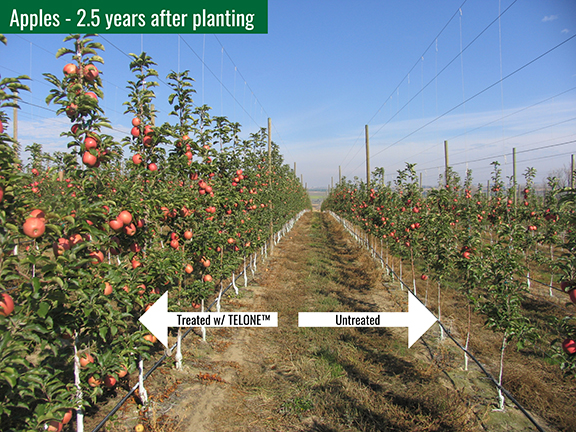How to Approach Biocontrol in Your Grape Vineyard

Along with integrating biocontrols into a biointensive block at Silver Thread Vineyard, Co-Owner and Winemaker Paul Brock manages the grape vines using an alternative to hedging called palissage, where vines are grown in a vertical-shoot positioned system and shoot tips are tucked or wrapped around the top wire of a trellis to control vigor.
Shifting to a biological-based spray routine is a complete change in mindset, says Paul Brock, Winemaker and Co-Owner of Silver Thread Vineyard in Lodi, NY. Brock says you shouldn’t expect to use biological products in the same way as conventional products. He likens this approach to being proactive instead of reactive. “It’s a different approach to growing because you have to apply the product ahead of time and then give the plants time to react to it,” he says. “A lot of it is induced responses by the plant, such as developing thicker grape skins, increasing the phenologic compounds of the grapes, and encouraging the plants to be more robust.”
Change Your Mindset
Brock gives the example of a grower who wants to spray early in the season, at the 10-inch growth stage, because it’s going to rain tomorrow. With the biointensive approach, it’s too late to spray because the rain will wash off the spray before it does any good.
“Some of these materials have an immediate response, but most of the responses from a lot of these products occur in four to five days,” Brock says. “You need to get that spray on four to five days before it rains so the vine is fully prepared for whatever disease pressure might come next.”
This line of attack can mean managing the vineyard more intensively, which means more sprays. While Brock says it has been a dry summer, he continues to spray to maintain the vine’s immunities since he’s not sure four to five days out when the next infection period for downy mildew will come.
He says the product needs to be on the plant “so the plant has its various defenses for a period of disease control.”
“Several vineyards in the area reported some downy mildew and powdery mildew, and we haven’t seen any of that in our biointensive block,” he says.
As far as insect control, Brock takes on an IPM mindset, where populations are controlled but never eliminated. Leafhoppers are in his vineyard, but he knows the populations will be reduced once he applies a biopesticide. He also knows populations will likely build back up between sprays every four to five days.
“I’m not worried about eradicating anything,” he says. “I’d much rather have a few leafhoppers around than come in and sterilize the vineyard.”
With all his sprays, Brock says he uses an organic spreader-sticker because most of the product instructions recommend pairing the spray with a spreader-sticker for better coverage.
“Think through all those things to make sure you get the most out of the products that you’re spraying,” he says.
Think Through the Total System
Brock says winegrape growers need to look at their vineyard as a total system when using biological products — that means taking a deep look at the nutrient compounds in the soil and how those play into what the vine needs.
Silver Thread Vineyard uses a palissage growing system where growers wrap shoots along the top catch wire in a vertical shoot position, or VSP, system or tuck them into the trellis. Brock says this system helps cut down on excess vigor and, in turn, gets more light into the canopy. With fewer lateral shoots crowding the fruiting zone, he’s also noticed a reduction in disease pressure.
“Part of this whole bio thing is using all of your growing factors — in this case, the abiotic sunlight that rains down on us,” he says. “We need to use that to have an effective biointensive program. We do extensive leaf pulling in the canopy and in the fruiting zone, so the ultra-violet radiation gets on the fruit and helps prevent diseases.”
Brock also plants fescues to boost the vineyard soil’s nutrient profile. The fescues and other under-the-vine coverage compete for a little water but also help boost soil health.
“I’ve got wall-to-wall green everywhere I look under the vine and between the rows, and that is helping to improve our soil structure,” he says. “Instead of just having cultivation under the vines, or an herbicide-strip under the vine, we have stuff growing to keep the soil together and promote the ecosystem.”
The hope, too, is that the under-the-vine crops create a better environment for beneficial insects in the vineyard to help reduce pest pressure. Brock says he’s also noticed a residual effect with predatory birds, as well.
“The fescues are great homes for mice,” he says. “Since we’ve had the fescues, we’ve had an increase in birds of prey, which is helping keep nuisance birds away that may damage fruit.”
Biocontrol Is the Right Thing to Do
For Brock, when he considers some of the reentry intervals of conventional sprays, he’s quite happy with using biocontrols. His vineyard may not be one of those picture-perfect vineyards with a clean undervine where everything is hedged, but to him, it is beautiful.
“It’s the right thing to do,” he says of using biocontrols. “It’s not just about what is best for my vineyard. [Many of] these products have four-hour reentry intervals; I like that. The whole idea is to get better grapes and better quality wine,” he says of using biocontrols. “As long as we get clean fruit in the end, we’re going to make some really nice wines with this approach. That’s the most exciting part for me.”










